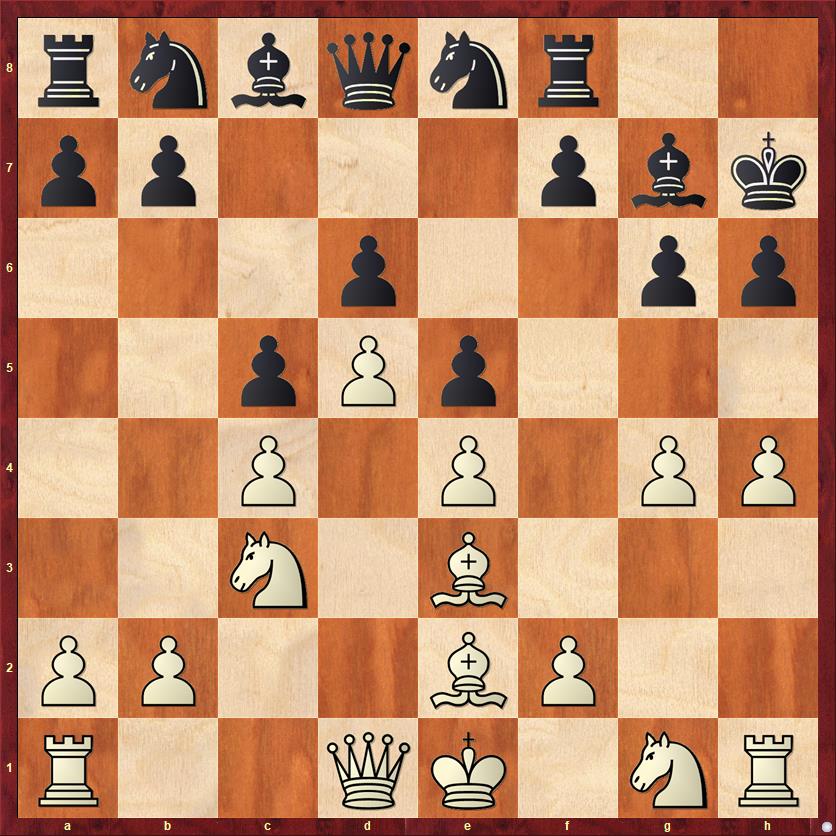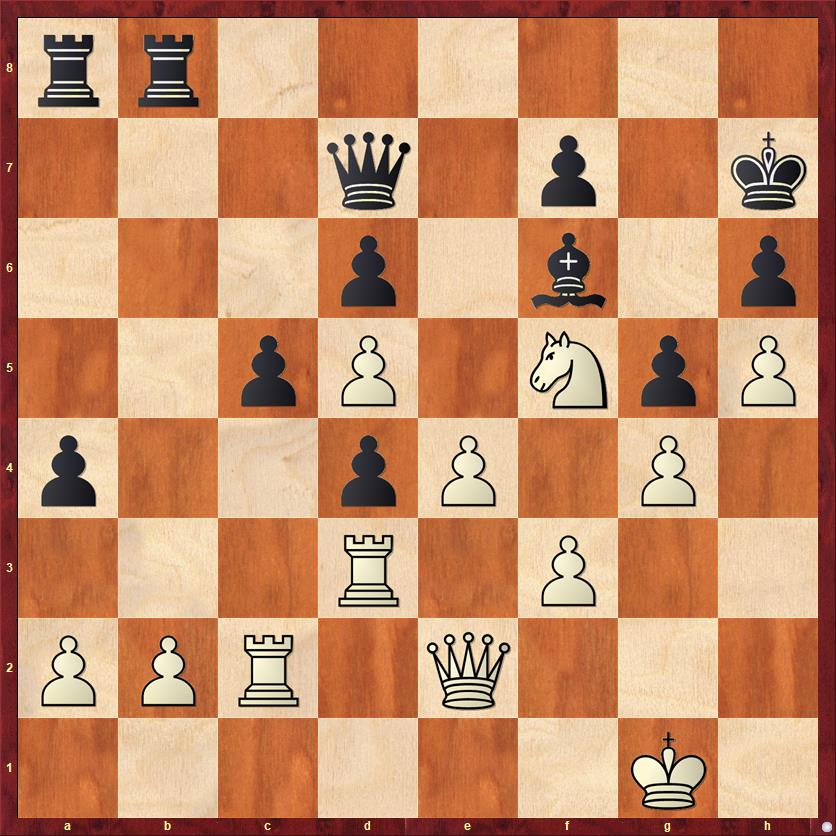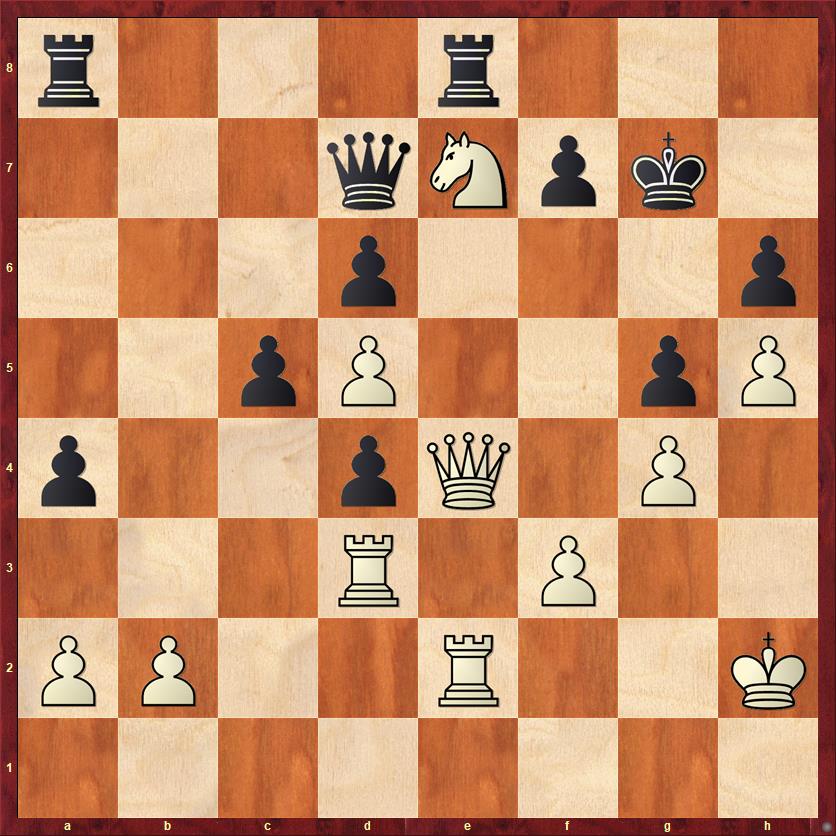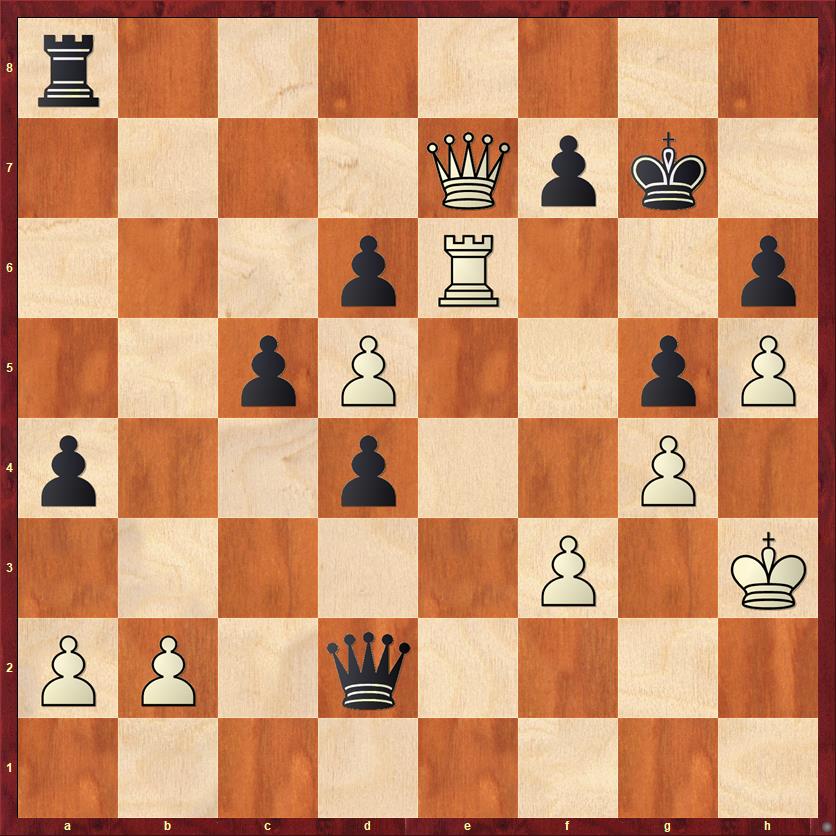I appreciate the patience of my readers with this retrospective of my chess career! Andy Lee, one of my Facebook friends, did a similar thing last year: for the 40 days leading up to his 40th birthday, he showed one position a day. His arrangement was not chronological but “countdown” style, with the last positions being his favorites. I really enjoyed following that series, although I have to admit that I didn’t look at every one of them.
One thing I can say is that Andy seems to be a better tactician than me. (His peak rating of 2405 is also a good deal higher than mine). While I’ve had some good tactical moments, in general I’m finding that very few of my games — even my favorite ones — are tactically “clean.” There is no better example of that than the game I’m going to show you today. It’s the first game I ever won against an International Master, and I have to say that the finish of the game is a comedy of errors. But at least they were deeply thought-out errors with not-so-obvious flaws. You can look at this game in two ways: either as proof that masters and International Masters can be really stupid too, or as proof that there is always more to learn about this game we love. Guess which interpretation I prefer?
My opponent was Ed Formanek, who at the time of this game was rated 2492, more than 300 points above me. He was the highest-rated player I have ever beaten. It makes me sad to see that he is now at his rating floor of 2200, and rated only 25 points above me. As far as I’m concerned, he was and always will be a much better player than me. But age has a tendency to humble us all.
Dana Mackenzie — Ed Formanek, 9/5/1992
1. d4 Nf6 2. c4 g6 3. Nc3 Bg7 4. e4 d6 5. Be2 O-O 6. Bg5 …
The Averbakh system has for years been my favorite way to meet the King’s Indian. I have no interest in playing the main line and defending against a pawn storm on the kingside.
6. … h6 7. Be3 e5 8. d5 Kh7 9. g4! c5 10. h4 …
Now it’s White who has a pawn storm!
10. … Ne8

FEN: rnbqnr2/pp3pbk/3p2pp/2pPp3/2P1P1PP/2N1B3/PP2BP2/R2QK1NR w KQ – 0 11
I wish I had a record of the amount of time I took on my next move. There are lots of interesting options to consider: h5, g5, Qd2, Qc2. The one I chose is okay but not the best, and it’s sort of a “rote” move. Either I didn’t have enough courage to play the best move, or I was playing on autopilot.
11. Qd2 …
This can’t be bad. But 11. g5! would have been a lot more fun. The point is that after the natural answer, 11. … h5, White is going to sacrifice a piece with 12. Bxh5! gh 13. Qxh5+. It’s hard for Black to get out of the pressure, because … f6 will always be met by g6 with a mating net. Meanwhile, White is planning to play Ne2-g3-f5 with a dangerous attack.
I’m sure that this idea never occurred to me back then. One reason it occurs to me now is that I have recently started playing the line 5. Ne2 and 6. Ng3, in which White also likes to lure Black into playing … h5 so that he can sacrifice a piece there. This shows the importance of not just learning variations, but also thinking about the ideas behind them.
11. … Na6 12. f3 Nc7 13. Bd1?! …
This seems unnecessarily passive; 13. Bd3 accomplishes the same goal of freeing e2 for the knight, while keeping the bishop more actively posted.
13. … Bd7 14. Nge2 b5 15. cb Nxb5 16. Nxb5 Bxb5 17. Ng3 …
It’s funny that in my notebook after the game I wrote, “after 14. … b5 Black achieves a dominating position fairly easily.” And yet the computer gives White a 1-pawn advantage after that move!
Why the difference? I think, first of all, that I was too intimidated by my opponent’s rating. When I look at the game now, I don’t see a single time when Black’s position was “dominating.”
Second, I think that I was too dogmatic and limited in my strategic thinking. I had one goal and one goal only, which was to open lines on the kingside and checkmate my opponent. That’s an exciting way to play chess, and it worked in this game! But it’s not the only way, and sometimes you have to be more flexible.
The computer’s idea here is to play 17. h5 g5. I’m certain that I looked at this possibility a zillion times (and eventually played it). But the computer’s followup would never have occurred to me: 18. b4! White is giving up on his kingside attacking ambitions, and playing on the queenside instead. White’s argument is that with the kingside locked up, the White king will be completely safe after castling. White’s minor pieces are better than Black’s: the knight has a nice outpost on f5 and White’s bad bishop has much more life than Black’s bad bishop. There’s a good chance that White will be able to trade light-squared bishops, after which White will simply have the better bishop. Finally, more concretely, after something like 18. … cb 19. Qxb4 Nc7 20. a4 a5 21. Qa3 (a plausible though not forced variation), it looks as if 22. Bb6 is coming, and Black will have a lot of weaknesses to worry about.
One lesson I draw from this is that I need to consider more plans. I never considered the move b2-b4, and Formanek proceeds to claim some space on the queenside. His position is never “dominating,” but it’s comfortable.
17. … a5 18. h5 g5 19. Nf5 a4
One point of this advance is that White now can’t play a2-a4, and Black will be able to relocate his knight to d4 via b5.
20. O-O Qd7 22. Rac1 Bxe2 23. Qxe2 Rfb8 24. Rc2 Nb5 25. Rd1 Bf6 26. Rd3 Nd4
This is arguably just a touch premature. Black could have prevented my counterplay in advance with 26. … Re8. But I can’t really consider it a mistake.
27. Bxd4 ed

FEN: rr6/3q1p1k/3p1b1p/2pP1NpP/p2pP1P1/3R1P2/PPR1Q3/6K1 w – – 0 28
Now comes my favorite move of the game.
28. e5! …
At the cost of a pawn, White finally gets to pursue his long-awaited dream of a kingside attack. That h7 square no longer looks quite as comfortable as before.
28. … Bxe5
The main alternative was 28. … Re8 29. Nxd6. Black has a couple interesting ways to sacrifice the exchange: 29. … Qxd6 30. ed Rxe2 31. Rxe2 or 29. … Bxe5 30. Nxe8 Rxe8. In both cases the computer says it’s equal but I think that White has all the winning chances. If Black doesn’t want to sac the exchange, he can play 29. … Rxe5 30. Ne4 Be7 31. d6! with a complicated game.
29. Qe4?! …
The computer spots a very nice idea here: 29. Rxc5! Now it’s White who sacrifices the exchange, and Black dares not take it: 29. … dc? 30. Qxe5 and the dual threats of Qg7 mate and Qf6 are just annihilating. However, let’s not celebrate too soon. Against this computer discovery there is also a computer-like response, 29. … Rxb2! In the wild complications after this move the computer says that the game would fizzle out to a draw: 30. Qxb2 dc 31. Qb6! f6 32. Qxc5 Rc8 33. Qa3 Rc3! (a powerful move, after which White just draws by the skin of his teeth) 34. Rxc3 dc 35. Qf8! c2 36. Qxh6+ Kg8 37. Qg6+ Kf8 38. Qh6+ and it turns out that Black can’t get away from the perpetual check.
Wow! That line is a true high-wire act. In human play, I’m sure that one or the other player would have made a mistake. As we’re about to see, the two humans involved were a long way from understanding this position.
29. … Bh2+??
A hallucination, and a good example of what happens when the stronger player gets too caught up in the psychology of being the stronger player. Presumably he thought this was a brilliant way to end the game because my queen would be trapped on e4.
The correct move was 29. … Kh8!, and I’m glad to say that I figured this out after the game without computer help. Black gives back the pawn but finally gets his “dominating” position after 30. Nxh6 Re8 31. Qf5 (there’s no really good alternative) Qxf5 32. Nxf5 Bf4. Although material is even, everything else in the position favors Black. His bishop has now turned into an active piece. His rooks have great files, the b-file and e-file. White’s rooks are totally passive. White’s one trump card, the passed h-pawn, is not going anywhere for a very long time.
30. Kxh2 Re8 31. Ne7+ …
It seems hard to believe that Formanek could have overlooked this obvious response. I think that what he overlooked was in the next position.
31. … Kg7 32. Re2 …

FEN: r3r3/3qNpk1/3p3p/2pP2pP/p2pQ1P1/3R1P2/PP2R2K/8 b – – 0 32
My hunch is that when Formanek played 29. … Bh2+??, he saw this position coming and thought he would win back the piece with 32. … Kf6. Unfortunately, this walks right into a mating net after 33. Qh7!, threatening 34. Qxh6 mate. Black would have to play 33. … Rh8, but then 34. Qf5+ Qxf5 35. Nxf5 rescues the knight.
Another possibility is that Formanek was planning to win back the piece with 32. … Ra7, but this move fails to 33. Nf5+.
He must have been really annoyed with himself at this point, but he keeps his wits about him and sets a trap… which I fell right into.
32. … Qb5 33. Kg2?? …
To be honest, I don’t remember any more whether this was just a clueless blunder, or whether it was an intentional blunder along the lines of Black’s 29th move. I’d like to believe it was the latter. My hypothesis is that I saw Black’s trap and decided to let him play it, thinking that I had a winning position afterwards. Alas, my analysis was flawed…
Better was 33. Rd1, with the simple idea of bringing a third defender to the e-file. I was worried about Black causing trouble with … d3, but there doesn’t seem to be a good way for him to do that.
33. … Rxe7! 34. Qxe7 Qxd3 35. Re6! …
Forcing checkmate! Or so I thought.
35. … Qd2+ 36. Kh3 …

FEN: r7/4Qpk1/3pR2p/2pP2pP/p2p2P1/5P1K/PP1q4/8 b – – 0 36
Here the obvious move is also the right move. Poor Ed, he kept playing fancy moves in this game when the simple moves would have worked.
36. … Kg8??
Correct is 36. … Qf4. But the hard part is seeing why it’s correct. After 37. Rg6+ Kh7 38. Rf6, isn’t White just winning?
You get full credit only if you see the jaw-dropping defense, 38. … Ra7!! I call this an “x-ray defense,” where the defending piece (the rook on a7) defends another piece (the pawn on f7) “through” the attacking piece (the queen on e7). It’s a somewhat standard idea, but I have never seen a position before where it happened in two directions simultaneously. Blacks queen on f5 is also defending the pawn on f7 via an x-ray defense through White’s rook on f6. Note also that Black’s queen and rook are both hanging, but unfortunately White isn’t allowed to take them both in one move.
All in all, an amazing idea. Chess never stops surprising us.
After the move Formanek played, the game rapidly comes to an end.
37. Rg6+!! …
The move that Formanek thought he was preventing! This is one of my favorite chess maxims: If your opponent thinks he’s preventing a move, look for a way to play it anyway.
37. … fg 38. hg Black resigns
The final position has a nice “David versus Goliath” aspect. Although White is a rook down, his g-pawn is much stronger than Black’s rook. The main point is 38. … Qf4 39. Qh7+ Kf8 40. g7+! Ke7 41. g8Q+ with mate next move.
What a crazy finish! Over the last ten moves, the evaluation of the position went from even to Black advantage to White win to Black advantage to White win again.
Lessons:
- “X-rays” can be used for defense as well as for attack.
- If your opponent think he’s preventing a move, look for a way to play it anyway.
- Simple moves sometimes are the right ones, even in complicated positions.
- When you study openings, try to learn ideas and not just moves.
- Be flexible, not dogmatic! Don’t be afraid to pivot when the position demands it. If you were planning a kingside attack, you may need to shift to the queenside. Or if you were planning a quick tactical solution, you may need to switch to a slow, strategic approach instead. Good players can win in a variety of ways.



{ 2 comments… read them below or add one }
Formanek is the first familiar name to me in this anthology. His game against Lombardy, where he lost as black in 17 moves, is featured in many books and articles about the Blumenfeld Gambit.
Because this is sort of a “highlights” series I’ve tended to bias my selection of games in favor of wins. Naturally I have more wins against class-A players you haven’t heard of than I do against famous Grandmasters. 😎
I have zero wins against Grandmasters, in fact. But I do have some draws, which I will probably show. And there’s no reason I can’t present some of my losses to Grandmasters, as long as they are games where I played somewhat well.